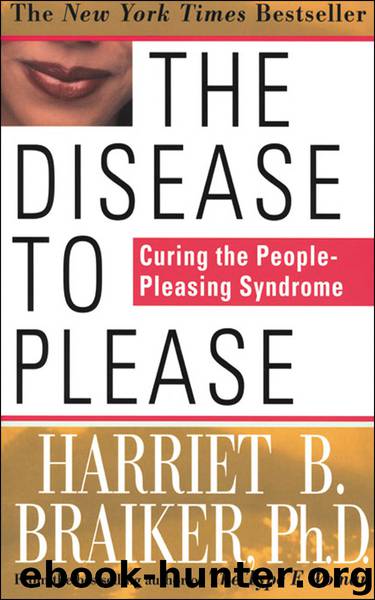The Disease to Please by Harriet Braiker

Author:Harriet Braiker
Language: eng
Format: epub
Publisher: McGraw-Hill Education
Published: 2001-04-04T16:00:00+00:00
Anger Is a Matter of Degree
Like many people, you probably have a number of misconceptions about the nature of anger that contribute to and inflate your fears. First, you may equate anger, which is an emotional state, with aggression, which is a behavior.
Aggression includes a deliberate intent to hurt, harm, or injure another, or to do damage to an inanimate object. Your fear of anger is based on the expectation that it will always lead to aggressive action, expressed either unilaterally or in the form interpersonal conflict.
Under certain circumstances, anger may indeed lead to aggression. However, it does not necessarily or inevitably do so. Learning to manage angry feelings and to express them effectively and appropriately greatly reduces the probability that aggression will develop when anger is aroused.
The second misconception is that anger functions like an on/off switch. In this inaccurate and polarized view, you are either calm and cool, or riled up and enraged. When anger is in the “off” switch position, you are clear and rational without visible signs of being upset or internal cues of anger. Once switched to the “on” mode, however, negative emotions are fully flared and you are now both manifestly and inwardly angry, agitated, and upset.
The black and white view of anger is simply incorrect. Anger doesn’t work only on a two-position on/off switch. Instead, anger develops incrementally, on an arousal scale
There is a great deal of individual variation, from one person to another, with respect to the speed with which anger escalates on the scale. Some people, known as “hot responders,” have a short fuse on their anger. For these types, the escalation from zero (no anger) to 100 (raging anger) occurs very quickly and can even create the illusion of an on/off phenomenon. Nonetheless, even the hot responders develop anger incrementally across increasing levels of arousal.
For other individuals, known as “cool responders,” anger increases more slowly along the scale. A cool responder ultimately can become every bit as enraged as the hot responding counterpart, but he or she just gets there in a slower, more deliberate fashion.
People also differ with respect to the frequency or incidence rate of their angry responses and on the type of incidents to which they respond with anger. The original research on Type A personalities uncovered a notably higher risk of cardiovascular disease that was believed to be associated with such characteristics as “hurry sickness” (i.e., feeling constantly pressured by doing too much in too little time), impatience, competitiveness, and free-floating anger and hostility.8 Over time, however, this rich vein of research on stress has demonstrated unequivocally that the real core of cardiac-proneness is chronic hostility and frequent outbursts of volatile anger.
Download
This site does not store any files on its server. We only index and link to content provided by other sites. Please contact the content providers to delete copyright contents if any and email us, we'll remove relevant links or contents immediately.
| Codependency | Conflict Management |
| Dating | Divorce |
| Friendship | Interpersonal Relations |
| Love & Loss | Love & Romance |
| Marriage | Mate Seeking |
The 5 Love Languages: The Secret to Love That Lasts by Gary Chapman(9588)
Doing It: Let's Talk About Sex... by Hannah Witton(9187)
Should I Stay or Should I Go? by Ramani Durvasula(7562)
The Road Less Traveled by M. Scott Peck(7522)
The Lost Art of Listening by Michael P. Nichols(7403)
Daring Greatly by Brene Brown(6444)
Beartown by Fredrik Backman(5594)
We Need to Talk by Celeste Headlee(5542)
Men In Love by Nancy Friday(5155)
The Rules Do Not Apply by Ariel Levy(4849)
The State of Affairs by Esther Perel(4637)
How To Win Friends and Influence People by Dale Carnegie(4441)
Reflections Of A Man by Mr. Amari Soul(4234)
Pillow Thoughts by Courtney Peppernell(4207)
The Ethical Slut by Janet W. Hardy(4172)
Algedonic by r.h. Sin(4010)
He's Just Not That Into You by Greg Behrendt & Liz Tuccillo(3830)
I Love You But I Don't Trust You by Mira Kirshenbaum(3805)
Surrounded by Idiots by Thomas Erikson(3771)
